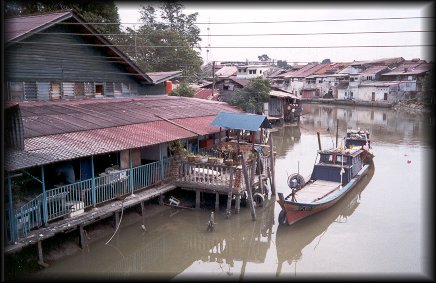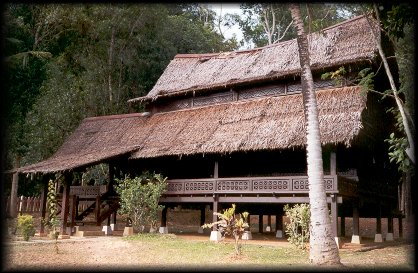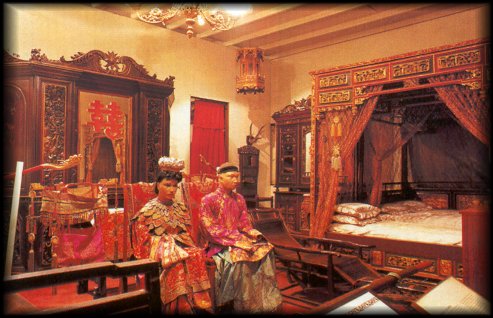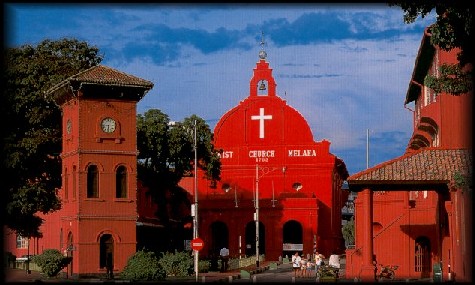Melaka, the Origin of Malaysia History, 2002
Day 1
A ride of Express Delima bus took me four and half hours to reach Melaka town from Singapore. I intended to make this trip free-and-easy yet cheap. Therefore, upon reaching the destination, I bought the bus ticket back to Singapore (which is supposedly cheaper in Malaysia) and obtained accommodation at Accordian Hotel whose rooms were cosy, air-conditioned, yet affordable.
After lightening my luggage burden and having Chicken Rice Ball as lunch, I set off to the Melaka town center which was once the colonial cores of Dutch and Portuguese. It was easily recognised by its buildings painted a uniform brick-red. I managed to catch the last boat trip up the Melaka River. The trip had a well-informed guide to point out interesting site along the murky river; such as slothful monitor lizards and little mud skippers lying at either river banks and living harmoniously with their human neighborhood, a thrown-away rice cooker being used as a flower pot, a loud boardcasting of swallows' chirping to lure them for bird's nest delicacy. Although Melaka river did not live up its reputation of 'Little Venice', it had its own uniqueness and surprises. The boat turned back at Kampung Morten, a small Malay village, and ended at the same boarding spot.

Melaka River, exactly where the movie, 'The Entrapment' was filmed
Next, I headed to Portuguese Settlement via local bus 17. It dwelled the Eurasian descendants of the Portuguese who conquered Melaka in the 16th century. The Portuguese settlement resembled a small simple Malay village, except that some residences were lit up for the late Christmas occasion. I had a taste of mock-up Portuguese cuisine for dinner, while waiting for cultural show held only at every Saturday. It was a half-hour Portuguese dance performance on a small stage with plain white background.
Day 2
Early morning, I travelled 14km north to Ayer Keroh by bus #105 (or #19). Many recreational places such as Melaka Zoo, Peacock Paradise and Auyin Hill Resort, were dispersed in Ayer Keroh and could be kilometers apart from one site to another. Because of time constraint, I concentrated my visit to Mini Malaysia and Mini Asean of Ayer Keroh, which were adjacent to each other. Mini Malaysia sited life-sized duplication of various traditional huts furnished with their individual house settings, to represent 13 states of Malaysia. Footwears had to be removed before entering each house. I was impressed by the authenticity of this place, especially the houses of Sabah and Sarawaks had floors and walls tiled with long bamboo stems. However, my visit turned gruesome when I spotted wild bats hanged on the ceilings and squeaked when they detected my intrusion!

An authentic 'kampong' replica in Mini Malaysia
I headed on the neighbouring theme park, Mini Asean, which was supposedly a summary of prominent cultural elements of ASEAN countries. I noticed a duplicate of a small Merlion statue representing Singapore. The pool was dead calm and covered with over-grown sea-plants and the trail paths were littered with tree leaves. It proved to me again that both theme parks were poorly managed. Their staff were as few as the visitors. It was a regret and waste to see the deterioration of both parks because their themes were original and their house exhibits were so nicely crafted. Perhaps they needed promotions to draw more attentions to their not-so accessible location.
I returned to Melaka town in the afternoon, and found myself in the west bank of Melaka river. Likewise in Singapore, worshiping sites of different religions stayed in harmony along the same street. For example, the oldest Hindus temple, Sri Poyyatha Vinayagar Noorthi Temple, was adjacent to the Islamic Kampung Kling's Mosque, and a distant away stood the Chinese Cheng Hoon Teng Temple. The East-West architectural influence of the Melaka mosques was reflected by their three-tier pyramid roof, unlike conventional dome, and their minaret structured like pagoda. Chinese temples displayed fine workmanship of ornately decorated mythological figures and large word carvings.
In preparation of coming Lunar New Year, the Chinese streets were hanged with rows of red-lanterns while some shops appeared reddish by displaying indoor new year decorations for sale. Jalan Hang Jebat, well-known as Jonker Street was a tourist attraction for selling artworks, antiques and souvenirs. Along this Chinese street was the Geographer Cafe where few scenes of Hongkong movie, Summer More More Tea, starring Sammi Cheng and Richie Ren, were shot. Fatefully, this was my consecutive location finding of Summer More More Tea while my first was at Pulau Redang (See the journal about my trip to Redang).
After having my lunch and a bitter taste of organic cucumber juice in Geographer Cafe, I strolled along Jalan Tun Tan Cheng Lock where rich Straits Chinese (whose male was called as Baba and female as Nonya) built their opulent townhouses. The Baba-Nonya Heritage Museum along this street was worthwhile to visit to get the unique insight of this peranakan lifestyle; such as Nonyaware porcelain, blackwood funiture made of marble and pearl inlay, traditional wedding and funeral costumes, ancestor altars.

Baba-Nonya Heritage Museum
I took a short break back to my hotel room before I proceeded to Sam Po Kong Temple. The temple was commemorated Cheng Ho, an eunuch from China's Ming Dynasty who opened up trading between China and Melaka. Bukit China was a small cemetery hill next to the temple and had become a jogging park now.
As evening drew near, I walked down to Melaka town center to catch the Light and Sound Show. It staged at the historical field center and re-enacted significant events of Melaka history by means of lights, narrations, dialogue, music and sound effects to project real-life drama. The show could be pretty boring as the lighting of several historical buildings was losing its dynamic impact as the long story narration dragged on. After the show ended, I had supper as satay celup which sticks of food varieties were self-cooked in satay sauce.

Melaka Town Centre
Day 3
My last day was spent in continuing the tour at town center. Unfortunately, several museums were closed down for renovations. Not far from the center was the St. Francis Xavier's Church, the Gothic-towered church dedicated to a saint. Christ Church and Stadthuys were testimonies to Dutch architectural ingenuity. The Melaka Sultanate Palace, a wooden palaca replica housing cultural museum, stood impressively at the foot of St Paul's hill. (Take a look at my sketch of the palace.) Beside the palace were the A'Famosa, the famous ruin of Portuguese fortress, and the Independence Memorial Museum, a former clubhouse. A short ascend up the St. Paul hill reached the St. Paul's Church, a Dutch burial ground and formerly known as Portuguese's 'Our Lady Of the Hill'. All these sites were concentrated in one place that I took only one hour or so to complete them. The Maritime Musuem was interestingly constructed after 'Flor De La Mar', a sunken Portuguese ship and stood majestically at the east bank of Melaka river. The museum narrated the Melaka history, from the Malay Sultanate to the Portuguese, Dutch and British colonial eras through exhibits of foreign ship models.

A'Famosa
Although Melaka did not bring me great astonishments, it was most uniquely remarkable to find all pocket traces of Chinese, Hindus, Malay, Portuguese, Dutch and British crowded in this small little peaceful town.